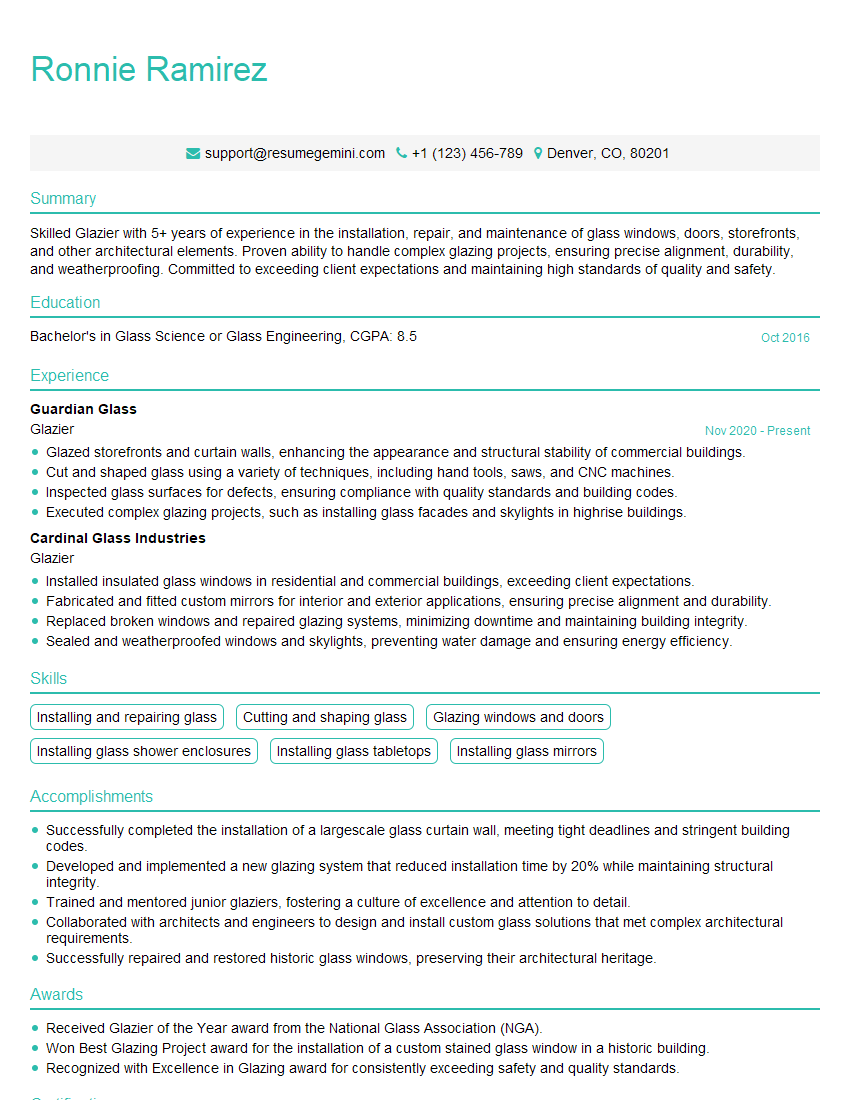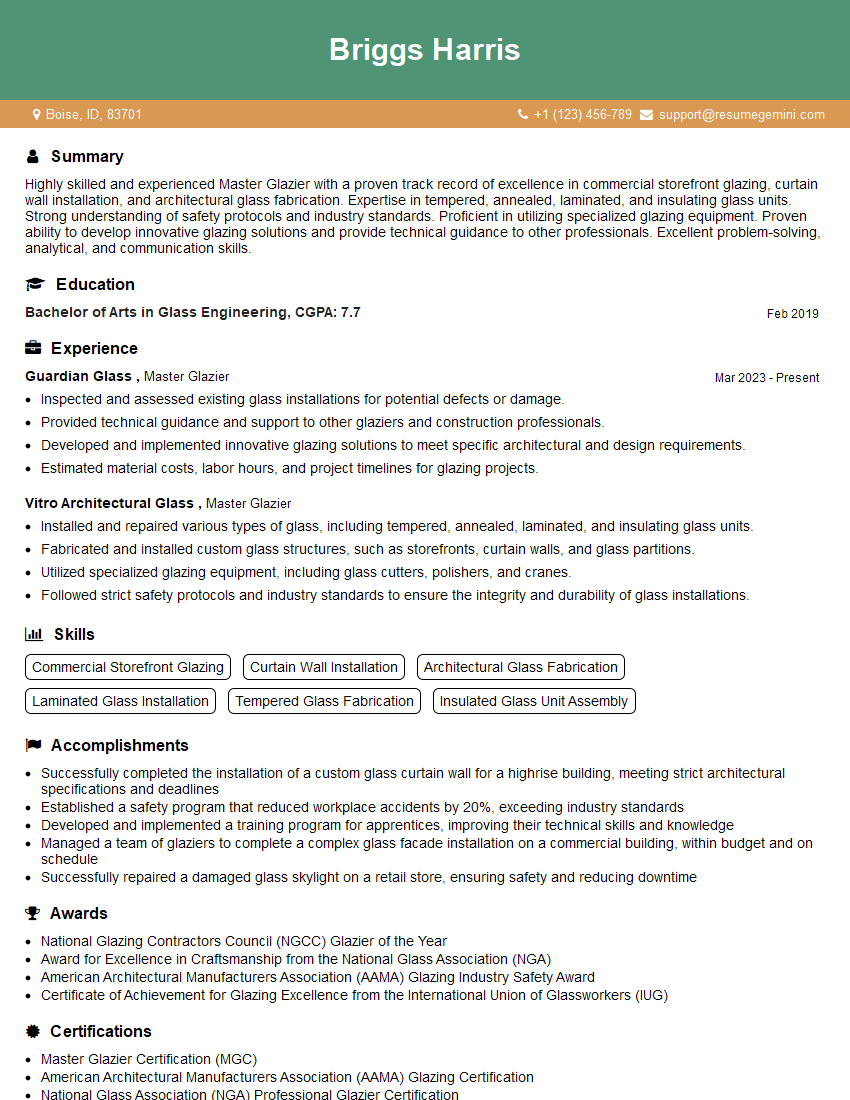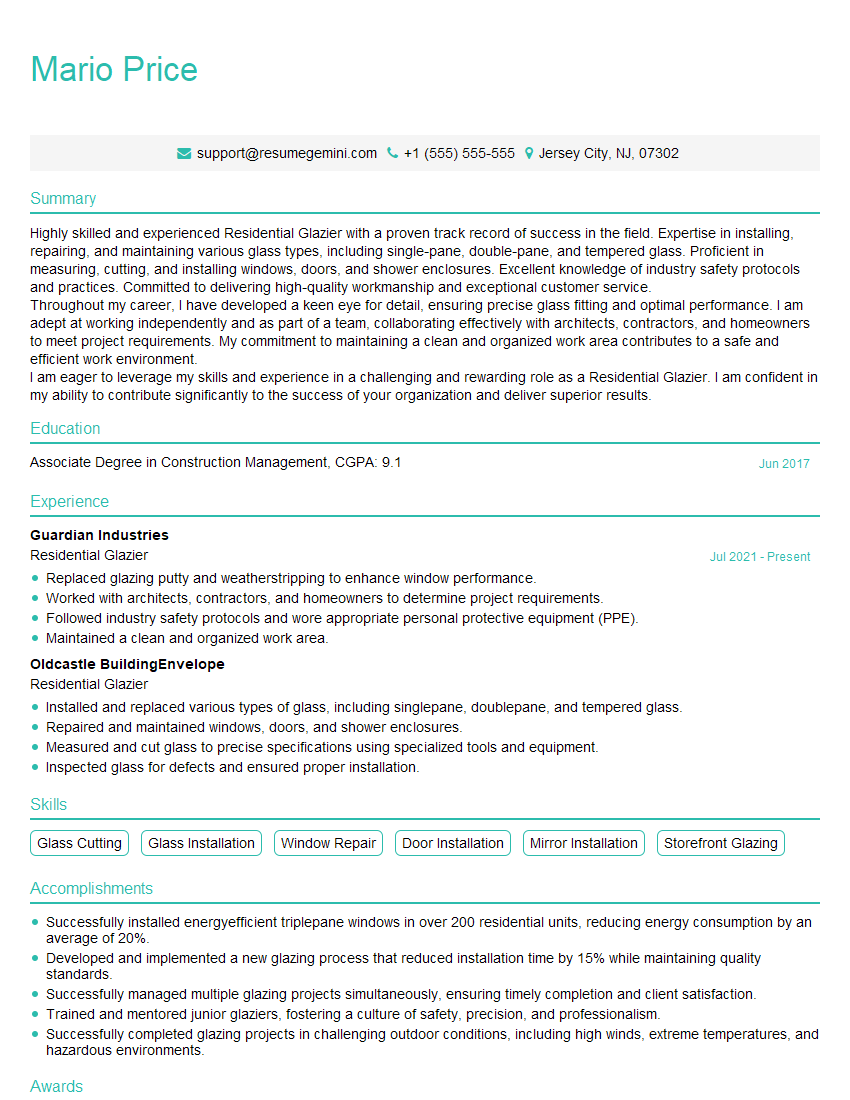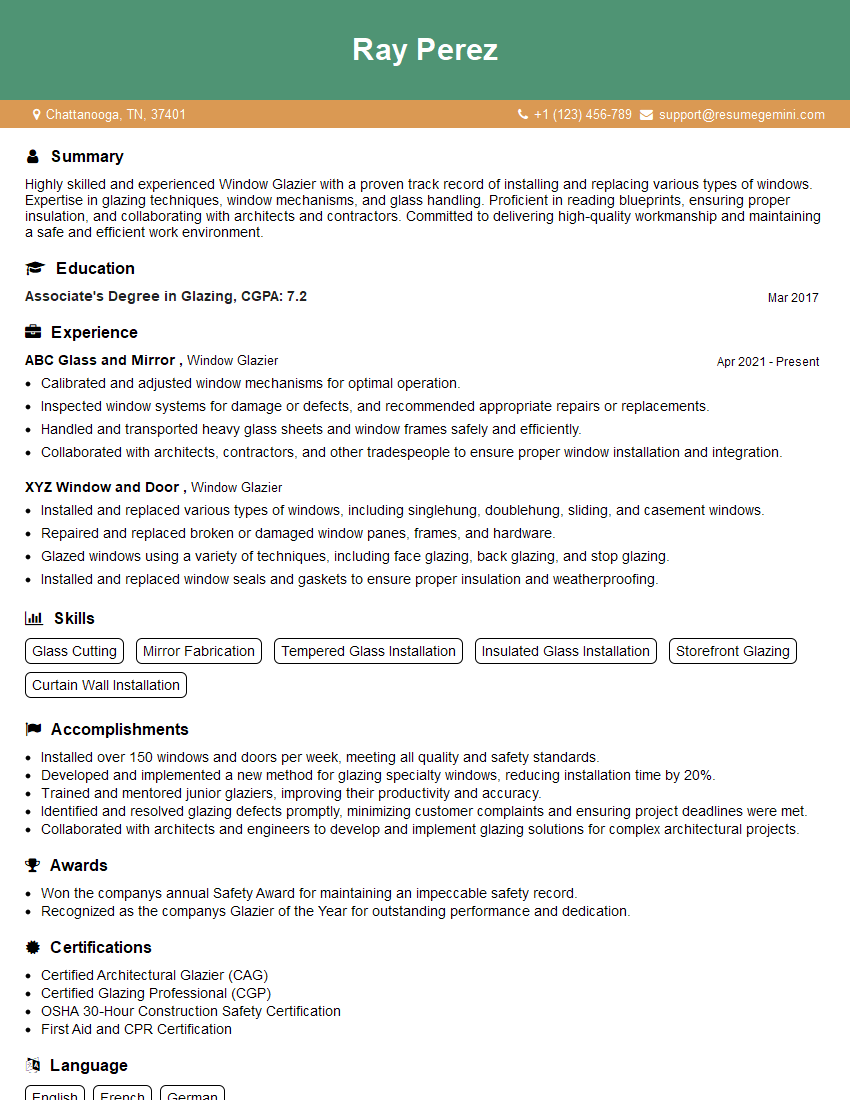The right preparation can turn an interview into an opportunity to showcase your expertise. This guide to Glazing windows and doors using putty interview questions is your ultimate resource, providing key insights and tips to help you ace your responses and stand out as a top candidate.
Questions Asked in Glazing windows and doors using putty Interview
Q 1. Describe the different types of putty used in glazing.
Putty used in glazing comes in several varieties, each with its own properties and applications. The choice depends largely on the project’s requirements and the type of glazing being undertaken.
- Oil-based putty: This traditional putty is a mixture of linseed oil, whiting (calcium carbonate), and pigments. It’s known for its flexibility, durability, and ability to form a watertight seal. It’s excellent for exterior applications but requires longer drying time.
- Acrylic putty: A more modern alternative, acrylic putty is water-based and offers easier cleanup. It dries faster than oil-based putty and is less prone to cracking. However, it might not be as durable in extreme weather conditions.
- Polyester putty: This two-part putty is extremely strong and durable, ideal for large panes of glass or areas subject to significant stress. It offers excellent weather resistance but requires precise mixing and a quick working time.
- Paintable putty: Specifically formulated to accept paint, this putty is suitable for situations where a finished painted surface is required. It usually comes in a neutral color.
Choosing the right type is crucial for a successful glazing job. For instance, oil-based putty would be suitable for a historic building restoration where authenticity is desired, while acrylic putty might be preferred for a modern home renovation where speed and ease of application are important.
Q 2. Explain the process of preparing window frames for putty glazing.
Proper preparation of the window frame is paramount for a successful glazing project. Think of it like preparing a canvas before painting – a smooth, clean surface ensures good adhesion and a professional finish.
- Clean the frame: Thoroughly remove all dirt, loose paint, old putty, and any other debris from the window frame’s rabbet (the groove where the glass sits). A stiff brush, scraper, and solvent (if necessary) are essential tools for this stage. Removing all traces of old putty is vital for proper adhesion of the new putty.
- Repair any damage: Address any cracks, holes, or rot in the frame. Wood filler can be used to repair minor imperfections. For larger repairs, professional intervention might be necessary.
- Prime (if necessary): Depending on the frame material and the type of putty used, a primer might be necessary to improve adhesion. This is especially important with bare wood or treated wood.
- Ensure a clean, dry surface: Before applying putty, make sure the frame is completely clean and dry. Any moisture can impede proper adhesion.
Skipping this stage can result in poor adhesion, leading to leaks, drafts, and ultimately, the failure of the glazing.
Q 3. What are the key considerations for selecting the appropriate putty for a specific glazing project?
Selecting the right putty depends on several factors, each impacting the long-term success of the glazing.
- Location and climate: Exterior applications require a weather-resistant putty that can withstand extreme temperatures, rain, and UV exposure. Oil-based or polyester putty is typically preferred in these cases.
- Frame material: The type of frame (wood, metal, uPVC) influences the putty choice. Some putties adhere better to certain materials than others.
- Glass type: The thickness and type of glass can affect the amount of putty required and the type best suited for creating a strong seal.
- Aesthetic considerations: The desired final appearance plays a role. Paintable putty is necessary when a finished, painted surface is required.
- Project budget: Putty costs vary; balancing quality with budget is important. Less expensive putties may compromise durability and longevity.
For example, for a heritage window restoration, you’d choose a traditional oil-based putty that matches the historical context. For a contemporary window, a faster-drying acrylic putty might be more suitable.
Q 4. How do you ensure proper adhesion of putty to the window frame and glass?
Proper adhesion is critical for a long-lasting seal. Several techniques ensure this:
- Clean surfaces: As previously mentioned, meticulously clean both the frame and glass. Any dust or debris will prevent proper contact and adhesion.
- Proper putty preparation: Follow the manufacturer’s instructions for mixing and preparing the putty. For oil-based putty, ensure it’s the right consistency (not too stiff or too runny).
- Firm pressure: Apply firm but even pressure while seating the glass in the frame and applying the putty. This ensures good contact between the surfaces.
- Use a primer if needed: In some cases, a primer can significantly enhance adhesion. This is especially useful for bare wood or certain types of metal frames.
- Suitable putty type: Choosing the appropriate type of putty based on the substrate and the application will go a long way in ensuring that the putty adheres well.
A common mistake is not applying enough pressure, resulting in poor adhesion and potential gaps that cause drafts and leaks.
Q 5. Explain the techniques for applying putty evenly and neatly.
Applying putty evenly and neatly requires skill and practice. Here’s a step-by-step approach:
- Apply a consistent bead: Use a putty knife to apply a consistent, slightly over-sized bead of putty along the rabbet of the window frame, ensuring it completely fills the gap between the glass and the frame.
- Tooling the bead: With a wet finger or a specialized putty tooling tool, gently smooth and shape the putty, creating a neat, evenly distributed bead. Work the putty firmly into the joint to ensure a watertight seal.
- Maintain a consistent profile: Aim for a consistent profile along the entire glazing line. Avoid any gaps or excessively thick areas.
- Remove excess immediately: Remove any excess putty immediately using a clean, wet cloth or sponge. Don’t let the putty dry before cleaning it off.
- Allow for drying time: Allow sufficient drying time as per the manufacturer’s recommendations before applying any further coatings or finishing.
Practice on scrap pieces of wood and glass to develop the right technique before tackling your actual project.
Q 6. What tools and equipment are essential for effective putty glazing?
The right tools make the job easier and lead to a more professional finish.
- Putty knife: Various sizes are beneficial for different applications. A flexible blade is particularly helpful for reaching tight corners.
- Putty tool/smoothing tool: This tool, often made of plastic or wood, helps shape and smooth the putty bead.
- Glazing points/splines: These are used to secure the glass in the frame, providing additional support and preventing movement.
- Scraper: Used for removing old putty and cleaning the frame.
- Stiff brush: Removes dust and loose debris from the frame.
- Solvent (if needed): To clean the frame and remove stubborn residue.
- Measuring tape and pencil: For accurate measurements and marking.
- Clean rags or sponges: For cleaning excess putty.
Investing in good quality tools is a worthwhile expense; they contribute significantly to the quality and efficiency of the glazing process.
Q 7. How do you clean excess putty during and after the glazing process?
Cleaning excess putty is crucial for a neat, professional finish. Here’s how:
- During application: Keep a damp cloth or sponge handy and immediately wipe away excess putty as you work. This is much easier than trying to remove hardened putty later.
- After drying: Once the putty has dried slightly but is still soft, use a sharp scraper to carefully remove any remaining excess putty. Be cautious not to scratch the frame or glass. A damp cloth or sponge can then be used to finish cleaning the area.
- For hardened putty: If the putty has fully hardened, a more aggressive approach might be necessary. A heat gun can help soften it, making it easier to remove. Alternatively, a solvent (following the manufacturer’s recommendations) may be required. Use caution as some solvents can damage certain materials.
Remember, timely cleaning greatly reduces the effort needed to achieve a clean and professional finish.
Q 8. How do you prevent cracking or shrinkage of putty over time?
Preventing cracking and shrinkage in putty over time is crucial for maintaining the integrity and longevity of your glazing. The key is using high-quality, correctly formulated putty and ensuring proper application and curing. Think of putty like a delicate cake – if you don’t handle it carefully and give it the right environment, it will crack and crumble.
- Use the right putty: Choose a linseed oil-based putty, which is known for its flexibility and durability. Avoid cheap alternatives as they often contain less oil, making them prone to cracking.
- Proper mixing: Mix the putty thoroughly according to manufacturer instructions to ensure a consistent consistency. Lumps of putty are weak points that can lead to cracking.
- Appropriate application: Apply the putty evenly and firmly, ensuring good adhesion to both the glass and the frame. Overly thick or thin applications can both be problematic.
- Controlled curing: Avoid rapid drying by protecting the freshly applied putty from direct sunlight, extreme temperatures, and harsh winds. A slow, even cure is essential for a durable seal.
- Regular inspection: Periodically inspect the glazing for any signs of cracking or shrinkage. Addressing small issues early can prevent them from becoming larger problems.
For example, I once worked on a restoration project where the original putty had cracked extensively due to age and improper application. Replacing it with high-quality putty and paying close attention to the curing process resulted in a durable, long-lasting seal.
Q 9. Describe the process of glazing a window with multiple panes of glass.
Glazing a window with multiple panes of glass, like a double- or triple-glazed unit, requires precision and attention to detail. Each pane must be carefully seated and secured using putty to create an airtight and watertight seal. The process is similar to single-pane glazing but involves multiple stages.
- Prepare the window frame: Ensure the frame is clean, dry, and free of any debris.
- Apply the first bead of putty: Apply a consistent bead of putty to the rebate (the groove in the window frame) to create a bed for the first pane of glass.
- Position the first pane: Carefully place the first pane of glass into the rebate, ensuring it is properly aligned and seated.
- Apply spacer and glazing tape (if applicable): For double or triple glazed units, spacers are used between the panes to maintain the air gap. Glazing tape often aids in creating a consistent spacing.
- Apply the next bead of putty: Repeat the process for each additional pane of glass, ensuring a complete seal between each pane.
- Apply the final bead: Once all panes are in place, apply a final bead of putty to the outer edge of the glazing, ensuring a smooth and weatherproof finish.
- Allow sufficient curing time: Allow the putty to cure completely before painting or further work on the window frame.
Think of it like building a layered cake – each layer needs to be carefully placed and secured to create a stable and delicious (in this case, weather-tight) structure.
Q 10. How do you handle different types of glass (e.g., thick, thin, curved)?
Handling different types of glass requires adapting your techniques to ensure a secure and damage-free glazing process. The main considerations are the weight, thickness, and shape of the glass.
- Thick glass: Requires more putty and possibly additional support during installation to prevent sagging.
- Thin glass: Is more fragile and requires extra care during handling and installation to prevent breakage. More delicate putty application might be needed.
- Curved glass: Requires a flexible putty and careful attention to detail to ensure a seamless seal along the curves. It often needs to be shaped and worked into the curve to prevent gaps.
For example, when working with curved glass, I often use a putty knife with a flexible blade to accurately apply the putty along the contours. Using the right tools is key for success.
Q 11. What are the common challenges encountered during putty glazing and how do you address them?
Common challenges in putty glazing include:
- Poor adhesion: This can be caused by dirty glass or frame surfaces, or using incompatible putty types. Solution: Always clean surfaces thoroughly and select the right putty for the material of the frame.
- Cracking or shrinkage: Can result from using low-quality putty, improper mixing, or rapid drying. Solution: Use high-quality putty, mix thoroughly, and protect the glazed area during the curing process.
- Uneven application: Leads to gaps and weak points in the seal. Solution: Practice consistent and smooth putty application. Consider using a putty gun for larger projects.
- Glass breakage: This can occur due to improper handling or excessive force during installation. Solution: Handle the glass carefully and use appropriate support during installation.
- Incorrect glazing depth: Not setting the glass far enough into the rebate can result in leakage and compromise the seal. Solution: Understand the correct glazing depth, and use suitable tools for precise positioning.
Troubleshooting requires careful observation. A cracked seal might need repair, while a poorly adhered bead will require removal and reapplication.
Q 12. Explain the importance of proper curing time for putty.
Proper curing time for putty is essential for achieving a durable and long-lasting seal. The curing process allows the oil in the putty to oxidize and harden, creating a strong bond between the glass and the frame. Rushing this process can result in a weak and brittle seal prone to cracking and leakage.
The exact curing time depends on factors such as the type of putty, environmental conditions (temperature, humidity), and the thickness of the putty application. Generally, it can take several weeks, or even months, for the putty to fully cure. During this time, it is crucial to protect the glazing from the elements to ensure proper curing. Think of it like setting concrete – you wouldn’t build a house on freshly poured concrete, would you? Similarly, you shouldn’t stress a newly glazed window until the putty is fully cured.
Q 13. How do you determine the correct amount of putty needed for a specific glazing project?
Determining the correct amount of putty requires careful measurement and estimation. It depends on several factors:
- Dimensions of the glazing area: The larger the area, the more putty you’ll need.
- Depth of the rebate: A deeper rebate requires more putty to fill the space.
- Type of putty: Different putty types have varying volumes.
- Number of panes of glass: Multiple panes require significantly more putty.
A good approach is to make a precise measurement of the glazing area and then estimate the putty volume needed based on the depth of the rebate and the type of putty being used. It’s usually best to slightly overestimate to avoid running out. I’ve often found that creating a simple calculation based on the linear length of the glazing and the depth of the rebate to be a useful guide, and then using a little extra as a buffer. Many suppliers also provide guidelines on putty usage which can be helpful too.
Q 14. Describe different methods for cleaning and maintaining putty glazed windows.
Cleaning and maintaining putty-glazed windows requires a gentle touch to avoid damaging the putty. Harsh chemicals or abrasive cleaners can degrade the putty over time.
- Regular cleaning: Regularly wipe down the window frames and glass with a soft cloth and mild soapy water.
- Spot cleaning: For stubborn dirt or grime, use a soft brush or sponge and a gentle cleaning solution, avoiding harsh chemicals.
- Inspect for damage: Regularly inspect the putty for any signs of cracking, shrinkage, or damage. Small cracks can be repaired with appropriate putty, preventing larger issues in the long run.
- Avoid power washing: High-pressure water can damage the putty, and therefore it’s best to avoid.
- Re-pointing: Every few years, a thorough inspection and potential re-pointing of the putty may be necessary, especially in harsh weather conditions or older buildings. This involves carefully removing deteriorated putty and replacing it with fresh putty.
Think of it like caring for a piece of antique furniture – gentle cleaning and regular maintenance will keep it looking its best and prevent significant damage in the future. For example, I always recommend using a soft brush and lukewarm water for everyday cleaning, and I rarely resort to harsher methods unless absolutely necessary.
Q 15. What are the safety precautions necessary when working with putty and glass?
Safety is paramount when working with putty and glass. Always wear safety glasses to protect your eyes from flying shards of glass or putty. Gloves are crucial to protect your hands from cuts and irritation from the putty, especially oil-based putty which can be quite harsh on the skin. A dust mask is recommended, particularly when working with older windows that might contain lead-based paint. Work in a well-ventilated area to minimize exposure to putty fumes, and ensure you have a stable working surface to prevent accidental drops.
- Eye Protection: Safety glasses are non-negotiable.
- Hand Protection: Sturdy work gloves are essential.
- Respiratory Protection: A dust mask is recommended, especially with older windows.
- Ventilation: Work in a well-ventilated area.
- Stable Workspace: Ensure a secure, stable working surface.
Career Expert Tips:
- Ace those interviews! Prepare effectively by reviewing the Top 50 Most Common Interview Questions on ResumeGemini.
- Navigate your job search with confidence! Explore a wide range of Career Tips on ResumeGemini. Learn about common challenges and recommendations to overcome them.
- Craft the perfect resume! Master the Art of Resume Writing with ResumeGemini’s guide. Showcase your unique qualifications and achievements effectively.
- Don’t miss out on holiday savings! Build your dream resume with ResumeGemini’s ATS optimized templates.
Q 16. How do you repair damaged putty glazing?
Repairing damaged putty glazing involves carefully removing the old, cracked, or deteriorated putty. This is best done using a putty knife or a specialized glazing tool. Be gentle to avoid damaging the surrounding glass or frame. Once the old putty is removed, clean the area thoroughly to ensure a good bond for the new putty. Then, apply new putty, pressing it firmly into the groove and ensuring a smooth, even surface. Finally, smooth the putty with a damp finger or a smoothing tool, creating a neat and watertight seal. Allow the putty to cure completely before painting or finishing the window.
Remember, for significant damage, replacing the entire glazing bead might be necessary.
Q 17. Describe the difference between oil-based and water-based putty.
Oil-based and water-based putties have distinct characteristics. Oil-based putty, traditionally linseed oil-based, is known for its durability and flexibility. It creates a very strong, long-lasting seal, but it takes longer to cure (several weeks) and can be messy to work with. It also tends to yellow over time. Water-based putty, on the other hand, is faster drying, cleaner to use, and easier to clean up. It’s generally less durable and flexible than oil-based putty, making it less suitable for exterior applications or areas exposed to harsh weather conditions. The choice often depends on the application and desired lifespan of the glazing.
Q 18. What are the advantages and disadvantages of using putty for glazing?
Putty glazing offers several advantages, including its traditional aesthetic appeal, creating a historically accurate look for older buildings. It’s also highly durable when the right type of putty is selected and applied correctly. It’s relatively inexpensive compared to other glazing methods. However, putty glazing requires skill and patience; the process is time-consuming and prone to errors if not done properly. It also requires regular maintenance; over time, putty can shrink, crack, or deteriorate requiring repair or replacement.
Q 19. How does the type of window frame material affect the choice of putty?
The window frame material significantly impacts putty selection. For example, wood frames are usually best suited to oil-based putty because it can flex and move with the wood as it expands and contracts with temperature changes. Oil-based putty adheres exceptionally well to wood. With metal or uPVC frames, a flexible, paintable putty that offers good adhesion to these materials is preferred. Avoid using a putty that is too hard or brittle as it might crack under stress. Always check the manufacturer’s specifications to ensure compatibility with your frame material.
Q 20. Explain the process of glazing a door using putty.
Glazing a door with putty is similar to glazing a window, but the larger size and potential for movement need careful consideration.
- Prepare the Surface: Clean the door frame and glass thoroughly, removing any old putty, paint, or debris.
- Apply the Putty: Apply a generous bead of putty into the rebate of the door frame, ensuring complete coverage.
- Insert the Glass: Carefully insert the glass pane into the frame, pressing firmly to seat it correctly.
- Smooth the Putty: Use a putty knife or your finger (with a glove!) to smooth the putty, ensuring a neat and even finish, creating a slightly concave profile to shed water.
- Clean Up: Wipe away any excess putty.
- Cure: Allow the putty to cure completely before painting or finishing the door.
For large doors, it is often recommended to use multiple smaller panes of glass to improve structural integrity and ease of handling.
Q 21. How do you ensure a watertight seal when glazing with putty?
A watertight seal when glazing with putty is crucial for preventing drafts, water ingress, and damage to the window or door. Achieving this involves using the right type of putty, preparing the surfaces adequately, and applying the putty correctly. Ensure the putty is properly compressed into the rebate, creating a good bond with both the frame and the glass. The use of a slightly concave profile in the applied putty helps to channel water away from the glazing. After the putty is cured, consider applying a high-quality sealant or paint for extra protection. Inspect the glazing regularly for any signs of cracking or deterioration and repair promptly.
Q 22. What are the signs of improperly applied putty?
Improperly applied putty is easily detectable. Think of it like a poorly applied bandage – it won’t stay on securely and will show obvious signs of distress. Common indicators include:
- Cracks or Shrinkage: Putty that shrinks or develops cracks after drying indicates poor quality putty, inadequate preparation of the surface, or insufficient application.
- Uneven Surface: A bumpy or uneven putty bead suggests inconsistent application pressure or a lack of smoothing after application. This not only looks unprofessional but also compromises the seal.
- Gaps or Holes: These are clear signs that the putty hasn’t fully filled the gap between the glass and the frame, leaving vulnerable points for drafts and water ingress.
- Discoloration: Significant discoloration or yellowing can indicate the use of inferior or improperly stored putty. Exposure to UV light can also cause this, but a sudden, uneven discoloration points to a problem with the application itself.
- Early Failure: Putty failing prematurely, such as within a year, points to poor-quality materials, incorrect application techniques, or inadequate surface preparation.
For example, I once encountered a job where the previous glazier had used too little putty and failed to properly clean the surfaces. The result was numerous gaps, leading to significant drafts and eventually water damage. Proper application requires patience and attention to detail.
Q 23. How do you deal with different weather conditions during putty glazing?
Weather is a significant factor in putty glazing. Temperature and humidity directly impact the putty’s drying time and adhesion. Think of it like baking a cake – you need the right temperature and humidity for the best results.
- High Temperatures: In hot weather, putty can dry too quickly, leading to cracking and poor adhesion. It’s crucial to work in the shade and possibly use a slightly slower-drying putty.
- Low Temperatures: Cold weather slows down the drying process considerably. This can extend the project timeline and increase the risk of the putty not curing properly. You might need to use a putty specifically formulated for low temperatures or use a heat lamp (with caution!) to aid the curing process.
- Rain: Obviously, rain is a major issue. Putty needs time to cure before exposure to moisture. This necessitates scheduling the work carefully and using protective coverings as needed.
- Humidity: High humidity can affect the drying time. It might be necessary to adjust the amount of putty used or the method of application to account for this.
My approach is to always check the weather forecast before starting a job and adapt my techniques accordingly. For example, I’ve learned to use a slower-setting putty during summer months and incorporate more frequent weather checks when working outdoors.
Q 24. Explain the environmental impact of using different types of putty.
The environmental impact of putty varies greatly depending on the type. The choice of putty is a crucial decision for environmentally-conscious projects.
- Traditional Oil-Based Putty: These contain linseed oil, which is a renewable resource. However, the manufacturing process and the eventual disposal of the material can have environmental consequences. Oil-based putties require careful handling to avoid spills and waste.
- Modern Synthetic Putties: Many modern putties are based on synthetic polymers. While these may offer better performance in some situations, their environmental impact depends on the specific polymers used and their biodegradability or recyclability.
- Water-Based Putties: These are a more environmentally friendly option, with lower VOC (volatile organic compound) emissions and reduced reliance on petroleum-based materials. They are generally easier to clean up.
I always advise clients on the environmental implications of different putty choices, focusing on the product’s lifecycle, from manufacture to disposal. We aim to minimize waste and choose the most sustainable solution possible for each project.
Q 25. How do you ensure the longevity of putty glazing?
Ensuring the longevity of putty glazing requires a multi-pronged approach that begins with meticulous preparation and continues throughout the application and aftercare. Think of it like building a house – a strong foundation is critical for a long-lasting structure.
- Proper Surface Preparation: Thoroughly cleaning and preparing the surfaces (both glass and frame) is paramount. Any dirt, grease, or loose paint will negatively affect adhesion.
- High-Quality Materials: Utilizing high-quality, weather-resistant putty is essential. This investment safeguards against early degradation.
- Correct Application Techniques: Following the manufacturer’s instructions and employing proper techniques, such as using the correct tools and applying even pressure, is crucial for a robust seal.
- Regular Maintenance: Regular inspection and repainting or sealing of any exposed areas can significantly extend the lifespan of the glazing. This preventative maintenance is key to long-term success.
For instance, I’ve seen glazing last for decades when clients have followed proper maintenance procedures and initially used high-quality materials, properly installed. Conversely, neglecting maintenance leads to quick deterioration and costly repairs.
Q 26. What are the latest industry best practices in putty glazing?
The glazing industry is constantly evolving. Current best practices emphasize sustainability, performance, and efficiency.
- Emphasis on Sustainable Materials: The move towards more eco-friendly putties and glazing methods is prominent.
- Improved Application Techniques: New tools and techniques are continually developed to improve accuracy and speed of application. For example, specialized putty guns enhance precision.
- Focus on Energy Efficiency: Glazing techniques are often chosen to maximize energy efficiency through the use of high-performance glass and careful sealing.
- Increased Use of Data and Modeling: Advanced modeling and simulation techniques are used in design and selection of materials, optimizing the long-term performance of the glazing.
I stay abreast of these developments through industry publications, workshops, and continuous professional development. I constantly seek the most efficient and sustainable approaches in my practice.
Q 27. Describe your experience with different glazing techniques beyond putty.
While putty glazing holds a special place in my expertise, I’m also proficient in other glazing techniques. My experience extends to:
- Silicone Glazing: This method is popular for its flexibility and weather resistance, especially in modern constructions. It’s a different approach, requiring specific application techniques and tools.
- Butyl Glazing Tape: This is a quick and efficient method suitable for certain applications, but it has limitations regarding aesthetic appeal and potential degradation over time compared to putty.
- Glazing Beads: These are commonly used in conjunction with other glazing methods, providing a decorative finish and extra protection.
Each technique requires a different skill set and material understanding. I choose the appropriate technique based on the project’s specific requirements – architectural style, budget, and desired longevity.
Q 28. How do you handle customer inquiries or complaints related to putty glazing?
Handling customer inquiries and complaints is a crucial aspect of my work. I approach every interaction with professionalism and empathy.
- Active Listening: I begin by listening carefully to the customer’s concerns, ensuring I fully understand the issue.
- Thorough Inspection: A thorough on-site inspection is often necessary to accurately assess the problem. This allows for a clear diagnosis of the issue and possible causes.
- Honest and Transparent Communication: I explain the findings of my inspection clearly, providing a realistic assessment of the situation and potential solutions.
- Collaborative Problem-Solving: I work collaboratively with the customer to find the best solution, ensuring they feel heard and understood. This might involve repair, replacement, or further consultation.
For example, I once dealt with a complaint about glazing that seemed to be failing prematurely. Upon inspection, I discovered the previous glazier had used an inappropriate type of putty for the location’s climate. This open communication led to a satisfactory resolution that built trust and reinforced the value of professional expertise.
Key Topics to Learn for Glazing windows and doors using putty Interview
- Types of Putty: Understanding different putty formulations (e.g., oil-based, water-based, acrylic) and their appropriate applications for various glazing projects.
- Preparation Techniques: Mastering surface cleaning, prepping window frames and glass for optimal putty adhesion, and ensuring proper moisture control.
- Application Methods: Learning different application techniques for applying putty smoothly and evenly, including tooling and finishing techniques for a professional finish.
- Glazing Techniques: Understanding how to correctly bed and secure glass units into window frames using putty, ensuring a secure and weather-resistant seal.
- Troubleshooting Common Issues: Identifying and resolving common problems such as cracking, shrinkage, and adhesion failures during the glazing process.
- Health and Safety: Understanding and adhering to safety regulations and best practices when working with putty, including appropriate personal protective equipment (PPE).
- Tools and Equipment: Familiarity with the various tools and equipment used in glazing with putty, including putty knives, glazing tools, and cleaning implements.
- Maintenance and Repair: Understanding how to maintain and repair glazed windows and doors using putty to extend their lifespan and prevent future issues.
- Regulatory Compliance: Awareness of building codes and regulations related to glazing and the use of putty in window and door installations.
Next Steps
Mastering the art of glazing windows and doors using putty opens doors to diverse opportunities in the construction and renovation industries, offering a rewarding and skilled trade. To maximize your job prospects, it’s crucial to present your skills effectively. Creating an ATS-friendly resume is essential for getting noticed by potential employers. We strongly recommend using ResumeGemini to build a professional and impactful resume that highlights your abilities. ResumeGemini provides examples of resumes tailored to the glazing and putty application trade, helping you showcase your experience and qualifications effectively.
Explore more articles
Users Rating of Our Blogs
Share Your Experience
We value your feedback! Please rate our content and share your thoughts (optional).
What Readers Say About Our Blog
This was kind of a unique content I found around the specialized skills. Very helpful questions and good detailed answers.
Very Helpful blog, thank you Interviewgemini team.





